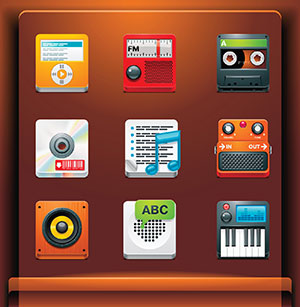Even though Reaper rivals the much more expensive digital audio workstation, Pro Tools, making the leap from Pro Tools to Reaper was not as simple as it might sound. Long-time Pro Tools users often get used to using the proprietary plugins (effects and virtual instruments). Pro Tools used a format called RTAS exclusively for most of its existence. But some plugin providers are now creating VST (Windows) and AU (Mac) versions of their plugins, which is awesome because Reaper uses those formats.
One example of a plugin provider who has done this is AIR Music Technology with their AIR Creative FX Collection. Below is a video from the Reaper Blog reviewing these effects in Reaper:
effects
12 Audio Recording Plug-ins All Costing Under $100
 One of the themes of Home Brew Audio is “affordable pro audio.” And in that vein, I thought our readers would be very interested in this post by Audiofanzine – 12 Quality Plug-ins for $100 or Less.
One of the themes of Home Brew Audio is “affordable pro audio.” And in that vein, I thought our readers would be very interested in this post by Audiofanzine – 12 Quality Plug-ins for $100 or Less.
Now when we say “plug-ins” in the audio world, we don’t just mean effects like reverb, EQ, compression, etc. The same technology that allows us to plug additional stuff into our recording software also encompasses virtual instruments. In fact, in Reaper (my favorite recording software), both virtual instruments AND effects are applied to tracks via the “FX” button. For Windows, the primary plug-in technology is “VST.” Others include DirectX, TDM, and MAS, to name a few.
I must admit that one reason I was attracted to this particular list of affordable plug-ins was that my current favorite reverb program – Valhalla – was on the list. So I figured the list must be decent:-P. Just kidding. Anything that comes from Audiofanzine is definitely worth a read. Other plug-ins on the list include EQs, compressors, delays, and filters.
Anyway – yes, the list! OK. Check out the article and list of plug-ins costing $100 or less at the following link:
http://en.audiofanzine.com/plugin-effects/editorial/articles/12-quality-plug-ins-for-100-or-less.html
Cheers!
Filters For Fun And Profit: What Do IIR And FIR Mean?
One of the most useful tools at your disposal when recording any kind of audio – music or voiceover – is good noise reduction. I wrote a post about the hidden noise reduction tool in Reaper that is actually just one function of a filter that comes free (along with dozens of other effects) with Reaper (www.reaper.fm), called ReaFIR. That post, along with the associated video, is: ReaFIR Madness – The Hidden Noise Reduction Tool in Reaper.
I made some wise crack about FIR standing for something technical and inscrutable. But in fact, Finite Impulse Response (FIR) is a type of digital audio filter with several uses to help you fix, enhance, or otherwise alter your audio. Here is an article that, along with its predecessor (the article, not the filter) about infinite response filters (IIR):
http://music.tutsplus.com/tutorials/filters-and-you-fir-filters–audio-23400
Auxiliary Sends For Effects
 I wrote about this topic once before in the post – Using Auxiliary Sends For Effects In Pro Tools. That article references a video from Wink Sound showing you how to use auxiliary sends in Pro Tools to process effects on a bass guitar track – as opposed to simply adding (instantiating is the word usually used here, meaning creating an “instance” of an effect) each effect directly onto the bass track.
I wrote about this topic once before in the post – Using Auxiliary Sends For Effects In Pro Tools. That article references a video from Wink Sound showing you how to use auxiliary sends in Pro Tools to process effects on a bass guitar track – as opposed to simply adding (instantiating is the word usually used here, meaning creating an “instance” of an effect) each effect directly onto the bass track.
Well, I wanted to add some things to what I said in that article. First, I stated that the main reason for using an auxiliary send was to save processing power on your computer. Though this is still a major benefit if you have multiple tracks all dipping their buckets (my metaphor) into the same effects (say, reverb) trough (a metaphor for the auxiliary track with the effect on it). However, that is not the only benefit of using an auxiliary send/track for processing some effects.
As shown in the example in the video, the main benefit is the extra control you have by processing the effect independently of the dry (meaning with no effects) audio from the bass track. In the video, Mike creates a new track – the auxiliary track – and puts a chorus effect on it. Then he uses something called a “send,” on the bass track, which basically just taps/siphons/splits off the audio signal so you can send it somewhere else, while the main bass audio continues to the master output as normal. The “send” is routed to the auxiliary track to be treated by the chorus effect.
So far, there isn’t much of an advantage to doing this as opposed to just sticking (instantiating) the chorus effect on the bass track, other than from an organization standpoint where you have both a dry and a wet signal to work with. But then Mike talks about adding an EQ to the aux track (which already has a chorus effect on it) in order to filter the chorus so that the chorus only happens in a certain frequency range. You wouldn’t be able to do that if you just slapped both the EQ and the chorus effects onto the bass track.
So to sum up ((ha! a little send/bus/aux pun for you:)), using a “send” from an audio track to process effects has multiple advantages. It allows you to create a common effect track that you can send multiple tracks in order to share the same effect (BTW, you use a “bus,” as explained in the video, to accept multiple track sends for summing. Tracks, like an auxiliary track, cannot usually accept inputs from more than one source. So you set that single source as the bus). And it also allows you the flexibility to process effects differently than you could if they were all just plugged into (instantiated) the audio track.
Below is that video I keep talking about. It uses Pro Tools, but the steps are the same in any digital audio workstation (DAW). However, things can get more flexible, and consequently more complex, in computer mixers like you have in DAWs. For example, in Reaper, tracks can also act as busses! That means tracks CAN accept multiple sends from other tracks. So you can set up a track as an effects bus, putting the effects on that track and sort of combining the aux and bus into one. So you wouldn’t have to route the send from and audio track first to a bus, and then to the aux track. Yeah, I know. That’s a bit confusing, even to me, to read it. I’ll write an article just on sends busses and auxiliary tracks to help it make sense.
Anyway, here is the video. I promise this time:).
Cheers!